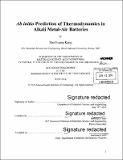| dc.contributor.advisor | Gerbrand Ceder. | en_US |
| dc.contributor.author | Kang, ShinYoung | en_US |
| dc.contributor.other | Massachusetts Institute of Technology. Department of Materials Science and Engineering. | en_US |
| dc.date.accessioned | 2014-09-19T21:30:44Z | |
| dc.date.available | 2014-09-19T21:30:44Z | |
| dc.date.copyright | 2014 | en_US |
| dc.date.issued | 2014 | en_US |
| dc.identifier.uri | http://hdl.handle.net/1721.1/89952 | |
| dc.description | Thesis: Ph. D., Massachusetts Institute of Technology, Department of Materials Science and Engineering, 2014. | en_US |
| dc.description | Cataloged from PDF version of thesis. | en_US |
| dc.description | Includes bibliographical references (pages 93-100). | en_US |
| dc.description.abstract | Electric vehicles ("EVs") require high-energy-density batteries with reliable cyclability and rate capability. However, the current state-of-the-art Li-ion batteries only exhibit energy densities near ~150 Wh/kg, limiting the long-range driving of EVs with one charge and hindering their wide-scale commercial adoption.1-3 Recently, non-aqueous metal-O₂ batteries have drawn attention due to their high theoretical specific energy.2, 4-6 Specifically, the issues surrounding battery studies involve Li-O₂ and Na-O₂ batteries due to their high theoretical specific energies of 3.5 kWh/kg (assuming Li 20 2 as a discharge product in Li-O₂ batteries) and 1.6 and 1.1 kWh/kg (assuming Na₂O₂ and NaO₂ as discharge products, respectively, in Na-O₂ batteries). Since the potential of Li-O₂ batteries as an energy storage system was first proposed in 1996,1 various studies have criticized and verified their shortcomings, such as their low power density, poor cyclability, and poor rate capability. ₇, ₈ Substantial research attempts have been made to identify the cause of the high overpotentials and electrolyte decomposition and to search for better cathode/electrolyte/anode and/or catalyst material combinations. However, Li-O₂ battery technology remains in its infancy primarily due to the lack of understanding of the underlying mechanisms. Therefore, we investigate the charging mechanism, which contributes to the considerable energy loss using first-principles calculations and propose a new charging mechanism based on experimental observations and knowledge concerning Li-ion and Na-ion batteries. Most studies on metal-O₂ batteries have mainly focused on Li-O₂ batteries. However, recently, the promising performance of Na-O₂ systems has been reported.₉, ₁₀ Although Na-O₂ batteries exhibit slightly lower theoretical specific energies than those of the Li-O₂ batteries as specified above, the chemical difference between the two alkali metals substantially distinguishes the electrochemistry properties of Na-O₂ and Li-O₂. In the Na-O₂ system, both NaO₂ and Na₂O₂ are stable compounds, while in the Li-O system, LiO₂ is not a stable compound under standard state conditions (300 K and 1 atm).₁₁, ₁₂ Presumably, due to this chemical difference, the Na-O₂ system has exhibited a much smaller charging overpotential, as low as 0.2 V, when NaO₂ is formed as a discharge product, compared with that in Li-O₂ system, >1 V. Such a low charging overpotential in Na-O₂ batteries demonstrates their potential as a next generation electrochemical system for commercially viable EVs .₉,₁₀ In this thesis, we study the thermodynamic stability of Na-O compounds to identify the phase selection conditions that affect the performance of Na-O₂ batteries. | en_US |
| dc.description.statementofresponsibility | by ShinYoung Kang. | en_US |
| dc.format.extent | 100 pages | en_US |
| dc.language.iso | eng | en_US |
| dc.publisher | Massachusetts Institute of Technology | en_US |
| dc.rights | M.I.T. theses are protected by copyright. They may be viewed from this source for any purpose, but reproduction or distribution in any format is prohibited without written permission. See provided URL for inquiries about permission. | en_US |
| dc.rights.uri | http://dspace.mit.edu/handle/1721.1/7582 | en_US |
| dc.subject | Materials Science and Engineering. | en_US |
| dc.title | Ab initio prediction of thermodynamics in alkali metal-air batteries | en_US |
| dc.type | Thesis | en_US |
| dc.description.degree | Ph. D. | en_US |
| dc.contributor.department | Massachusetts Institute of Technology. Department of Materials Science and Engineering | |
| dc.identifier.oclc | 890127745 | en_US |
